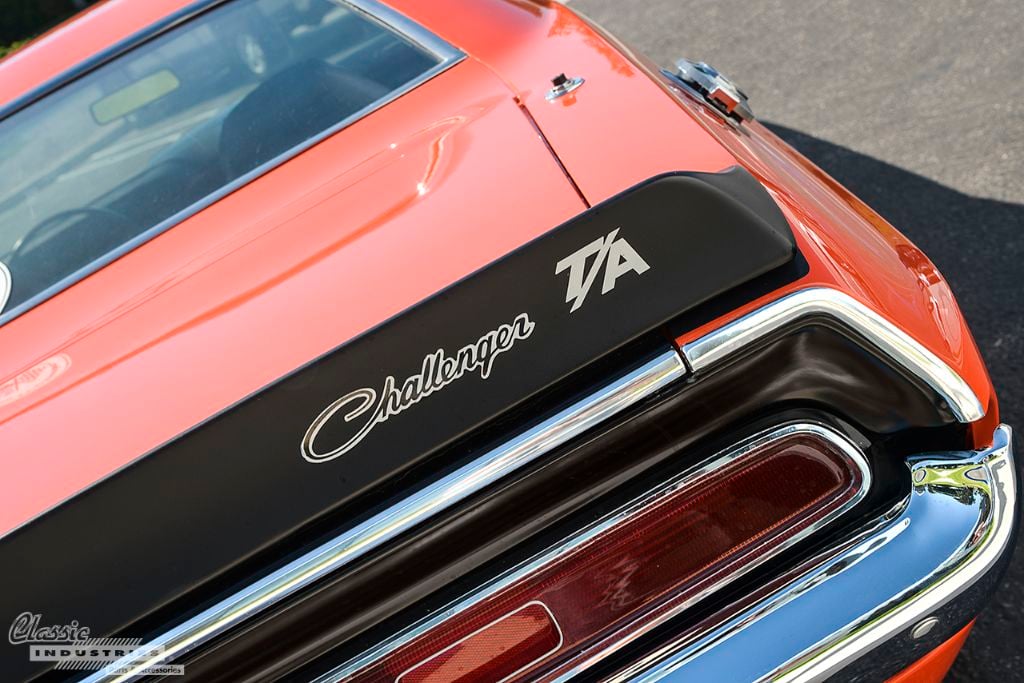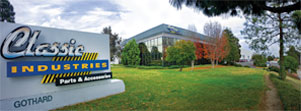 Few Mopars ignite as much passion - or start as many garage arguments - as the 1970–1974 Dodge Challenger. Born at the height of the muscle-car wars, the E-body Challenger blended Mopar attitude with a long-hood/short-deck Coke bottle profile and a factory engine lineup ranging from steady-Eddie 318s to the fire-breathing 426 Hemi V8. Today, these cars remain first-rate collectibles and prime candidates for either concours-level restorations or full blast restomods.
Few Mopars ignite as much passion - or start as many garage arguments - as the 1970–1974 Dodge Challenger. Born at the height of the muscle-car wars, the E-body Challenger blended Mopar attitude with a long-hood/short-deck Coke bottle profile and a factory engine lineup ranging from steady-Eddie 318s to the fire-breathing 426 Hemi V8. Today, these cars remain first-rate collectibles and prime candidates for either concours-level restorations or full blast restomods.
Both paths can lead to tire-shredding or show-stopping glory, but they take you down very different roads. Here’s a deep dive into the pros and cons of each, from cost and drivability to street cred and resale value.
Full Restoration: Rewinding the Clock to 1970

Above and below: 1970 Dodge Challenger R/T - The lead photo and the pics here are of a resplendent restoration of a 440 V8 equipped and four-speed manual backed 1970 Dodge Challenger R/T with the following specifications (photos courtesy of Mecum Auctions). -
- 440 CI V-8 engine
- 4-barrel carburetor
- Dual exhaust
- 4-speed manual transmission
- 3.54 Track Pak rear end
- FC7 Plum Crazy finish with Black vinyl top
- Black bucket seat interior
- Hurst Pistol Grip shifter
- Color-keyed mirrors
- Black longitudinal striping
- Hood hold down pins
- Rallye wheels


Restoring a Challenger is all about rolling back the odometer of time - returning the car to showroom-correct condition, right down to the chalk marks, paint dabs, and factory overspray.

Pros

Above and below: 1970 Dodge 426 Hemi V8 powered and four-speed manual backed artfully restored coupe (photos courtesy of Mecum Auctions):
- 1 of 137 Hemi 4-speed Challengers produced for 1970
- Comprehensive restoration
- Broadcast sheet
- Chrysler Registry Report
- Super Track Pak
- 426 CI Hemi V-8 engine
- 4-speed manual transmission
- Special order Sublime Green high impact exterior with Black Bumblebee stripes
- Black vinyl top
- Black interior
- Console
- Bucket seats
- Rim blow steering wheel
- Rallye gauges
- Goodyear Polyglas GT White-letter tires
- This car has been professionally maintained by Boo Boo's Garage of Stillwater, Minnesota

- Maximum Collector Value
Originality is king in the collector market. A numbers-matching R/T or Hemi Challenger restored to factory specs commands serious money. For investors or purists, this path holds the strongest long-term financial upside. Doing some research with a Mopar VIN Decoder & Fender Tag Decoder guide comes in handy, should you be interested in restoring your Challenger.
- Historical Preservation
A proper restoration keeps Mopar history alive. You're honoring the original engineering, the craftsmanship, and the soul of the era. Judges at Mopar Nationals or MCACN eat this stuff up.
- Proven Authentic Experience
Driving a factory-correct Challenger is like hitting a time warp. The smells, the sounds, the quirks—every bit of the nostalgia is intact. It’s pure muscle-car theater.
- Parts Availability Is Better Than It Used to Be
Thanks to reproduction panels, trim, and interior pieces, restoring an E-body is far more feasible today than it was 20 years ago (thanks to companies like Classic Industries).

The only 1970 Hemi Challenger R/T built with a factory sunroof is just below:

Above and below: 1970 Dodge Hemi V8 Challenger (photos courtesy of Mecum Auctions):

- The only 1970 Hemi Challenger R/T with factory sunroof
- The final restoration of renowned collector Steve Juliano
- Extensive concours restoration completed using original and NOS parts
- Original sheet metal
- Original drivetrain
- Featured in Mopar Action Magazine
- Sunroof installed by ASC in Detroit, Michigan and shipped to California
- Dual quad 426 Hemi engine
- NOS date-coded turned-down exhaust
- 4-speed manual transmission
- 4.10 Dana rear end
- Power steering and brakes
- R/T hood with hold-down pins
- Bucket seats and center console
- 6-way seat, Pistol Grip shifter
- Unrestored original dash
- NOS Rim Blow steering wheel
- Pedal dress-up kit
- 8-track player
- Assembly-line floor mats
- Black Bumblebee stripe and vinyl top
- Luggage Rack with vintage suit case
- Rare Goodyear 'No Size' F60-15 Polyglas tires and Rallye wheels
- Chrome mirrors and bumper guards
- Locking flip-top fuel lid
- ASC sunroof operating instructions
- Owner's manual in plastic sleeve
- Steering column lock instructions
- Warranty pamphlet

Cons
- Cost Can Skyrocket Quickly
NOS parts, rare trim, year-specific odds and ends… they add up fast. If you’re chasing concours correctness, prepare the checkbook and the spouse.
- Factory Limitations Remain
Early-’70s brakes fade, suspensions flex, steering wanders, and carburetors need babying. Restoration preserves the charm and the imperfections.
- You May Be Afraid to Drive It
A six-figure numbers-matching build becomes a garage queen. Weather, traffic, and parking lots suddenly feel like mortal enemies.
- Hard to Personalize
The whole point is originality, so big wheels, modern tunes, or performance tweaks are off the table.

Restomod: The Challenger, Reinvented for the 21st Century
A restomod blends the iconic E-body style with modern power, handling, comfort, and reliability. Think “classic look, modern muscle.”

Above and below: 1970 Dodge Challenger restomod convertible (photos courtesy of Mecum Auctions):
- Rotisserie restoration
- 6.4L Hemi engine
- Tremec 6-speed wide-ratio manual transmission
- Moser 9 inch rear differential with 3.23 gears
- AlterKtion front suspension
- Street-Lynx rear suspension
- Coilover shocks
- 4-wheel Wilwood disc brakes with Red powdercoated calipers with drilled and slotted rotors
- Vintage Air
- New Legendary interior
- Power windows operated by the controls in the center console
- Console holds a stereo, navigation, rear assist camera and carbon fiber pistol grip
- Power trunk release in the glove box as well as tilt steering column

Pros

Above and below: 1970 Dodge Challenger restomod (photos courtesy of Mecum Auctions):
- Over 3 years invested in professional rotisserie restoration
- 440 engine stroked to 512 CI
- Aluminum heads Comp Cams roller cam
- Hotchkis suspension steering and shocks
- Wilwood 4-wheel disc brakes
- Hot Rods by Boyd wheels with matching steering wheel
- Nitto Motivo tires
- Detroit Tru-Trac rear differential
- TTI headers and dual exhaust
- Vintage Air
- Custom interior by JS Customs
- Kindigit door handles
- Custom paint by Gnome
- Estimated $150,000 invested
- New glass







- Best-of-Both-Worlds Performance
Drop in a Gen III Hemi. Bolt on coilovers. Add Brembo or Wilwood brakes. Upgrade to rack-and-pinion steering. You end up with a Challenger that handles like a modern Charger Hellcat but still looks like a 1970-American muscle machine.
- No Fear Behind the Wheel
Restomods are built to be driven rain or shine, highway or canyon. They’re far more livable and less precious than museum-grade restorations.
- Unlimited Creativity
Wheels, paint schemes, digital gauges, serpentine systems, EFI, custom interiors - the sky’s the limit. It’s your Challenger, your personality.
- Reliability You Can Trust
Fuel injection, modern ignition systems, and upgraded cooling make for a car that starts, runs, and drives consistently without the daily drama of vintage tech.

Above and below: 1971 Dodge Challenger restomod (photos courtesy of Mecum Auctions):
- Build documentation
- Keith Black 528/760 HP Hemi V-8 engine
- Tremec 5-speed manual transmission
- Yellow exterior with Black stripes
- Black interior
- Bucket seats
- Sabelt safety belts
- Hurst Pistol Grip shifter
- VDO gauges
- Custom hood with hold-down pins
- Tubular K member front suspension
- 4-link Dana rear end
- Forgeline wheels
- Michelin Pilot Sport tires`1`


Cons
- Purists May Scoff
Hardcore Mopar historians will mourn the loss of originality - especially if you cut into a rare R/T or numbers-matching car.
- Costs Can Also Be Sky-High
A high-end restomod with a crate Hemi, modern chassis, and custom fabrication can easily rival the price of a top-tier restoration.
- Resale Value Is Less Predictable
While some builds bring monster money, others depend heavily on buyer taste. A restoration has a more objective standard; a restomod’s value is subjective.
- You Can't Go Back Easily
Modernizing often means irreversible changes - frame mods, wiring overhauls, custom metalwork. Once you restomod it, it’s not likely going back to stock.

Above: 1971 Dodge Challenger convertible - Mr. Norm's Continuation Challenger, Serial No. 001, Supercharged 6.2L/707 HP V8 restomod (photo courtesy of Mecum Auctions)
Restoration vs. Restomod: Which Is Right for You?

Go Restoration If…
- You’ve got a numbers-matching or high-spec car (R/T, 440 Six Pack, Hemi).
- You value originality and historical accuracy.
- You’re thinking long-term collector value.
- You want the classic ’70s driving experience - shortcomings and all.
Video: Dylan McCool Revives His Dad's Rare 1970 Dodge Challenger R/T Convertible
Go Restomod If…
- You want a classic daily driver or weekend canyon carver.
- You prioritize performance, drivability, and reliability.
- You enjoy customization and craftsmanship.
- Your car is a base-model or non-matching project—perfect restomod material.

Final Verdict: There’s No Wrong Answer—Only the Wrong Car for the Wrong Goal
The 1970–1974 Dodge Challenger is one of the most versatile muscle-car platforms ever made. Whether you’re resurrecting a survivor to concours glory or building a tire-shredding, fuel-injected monster, the key is choosing the path that matches your vision.
- Restoration honors the past.
- Restomods rewrite it.
Either way, you end up with a Mopar legend that turns heads and stirs souls.
Dodge Challenger Restoration Parts
























